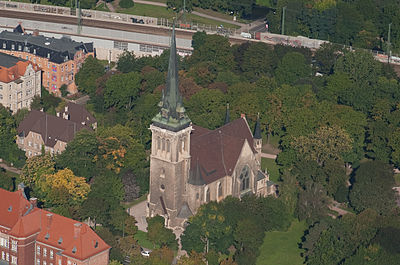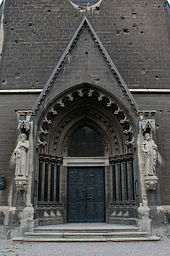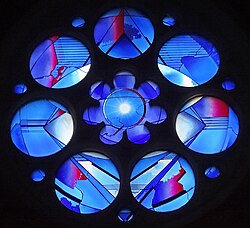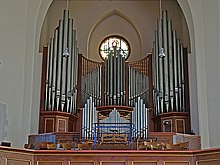Thomas Church (Erfurt)
The Thomaskirche is an evangelical uniate church in the neo-Gothic style and is located in a park on Schillerstraße in Erfurt , in the Löbervorstadt district . The church was built at the beginning of the 20th century as a replacement for the old Thomaskirche , which had become too small , and has the second highest church tower in the city at 72 meters. It serves as the parish church of the Thomas parish and houses a Gothic altar retable from 1445, which is one of the four valuable Erfurt carved altars.
history
Old Thomas Church
Main article: Old Thomas Church
The old Thomaskirche was a Gothic hall church on the corner of Löberstrasse / Rosengasse and served as the Protestant parish church of the Löbervorstadt until it was demolished in 1903. The parish stretched between the inner and outer city walls in the south of Erfurt until it was demolished in 1872. During the Middle Ages, this area was mainly inhabited by poorer people, such as day laborers, porters and the Löber who practiced the craft of tannery and gave the district its name. For this reason, the old Thomaskirche was one of the smallest church buildings in the city with simple architecture and few valuable inventory items, such as the carved altar from 1445. In 1282, the old Thomaskirche was first mentioned in writing in a document. Presumably in the first half of the 14th century it was rebuilt in Gothic style. It remained in this form until it was demolished, making it one of the few Erfurt churches that did not undergo major structural changes either as a result of city fires or because of disrepair. After Erfurt was deconsolidated in 1872, the Löbervorstadt moved south, whereupon numerous new residential buildings were built between Flutgraben and Steigerwald from 1890 and the old St. Thomas Church no longer offered enough space for the grown community. In addition, many wealthy citizens settled in the quarter who wanted a more representative and centrally located parish church. Thus the Thomas parish had developed from what was once the smallest and poorest to one of the largest and richest parishes in Erfurt.
Today's St. Thomas Church
After the laying of the foundation stone for the new St. Thomas Church on April 29, 1900, work began on a new neo-Gothic building in a park on Schillerstrasse under the direction of Pastor Alfred Fritzsche and the Hanoverian architect Rudolph Eberhard Hillebrand . It was decided to orient the church to the north, parallel to Viktoriastraße (today's Puschkinstraße) in order to escape the noise of the traffic in Schillerstraße. Master bricklayer Ferdinand Schmidt and master stonemason C. Walther were responsible for the exterior work, and the decorative painter Alexander Linnemann was responsible for the interior painting and design of the colored glazing . After two years of construction, the new St. Thomas Church with space for around 1,100 visitors was inaugurated on June 15, 1902 in a festive service. In return, the old St. Thomas Church was torn down a year later and valuable items of equipment, such as the altarpiece from 1445 and a sacrament house, were taken over in the new building. However, the reredos were not placed on the altar as in the old St. Thomas Church, but kept in the church hall next door. A multi-storey row house was built in place of the old Thomaskirche, on today's property at Löberstraße 18, which with its name Haus zum St. Thomas is reminiscent of the previous sacred building. Between 1910 and 1913 the parish and parish hall was built between the Thomaskirche and Puschkinstrasse. In the early 1930s, the altarpiece from 1445, which had been repainted with new colors in the 19th century, was restored to its original condition by the state curator Albert Leusch from Halle an der Saale. In 1902, all three bells of the old St. Thomas Church were melted down and the small "Luther", medium "Thomas" and large "Christ bells" were made, the smaller of which was withdrawn in 1917 and replaced in 1926 by a new cast. The larger bells had to be handed in during the Second World War , so that until the 1950s only the small "Luther bell" was available.
On the morning of March 31, 1945, three squadrons of the 3rd Air Division of the United States Army Air Forces (USAAF) consisting of numerous B-17 bombers reached the city of Erfurt and began an air raid on the central and southern urban area. Explosive bombs hit the eastern nave of the St. Thomas Church and badly damaged the roof and the outer wall in this area. Inside, the vaults, the galleries, the Walcker organ and the interior painting were badly damaged. Furthermore, all panes of the church windows broke and the statue of Christ above the main portal was lost. Based on internal reports by the USAAF, it later became apparent that this air attack had originally targeted the city of Gotha and that the target had been mixed up on that day due to the poor visibility.
As a result of the severe damage, the Thomas parish was no longer able to use its church for church services and had to move to the old Lutheran Christ Church on Tettaustraße. Despite adverse conditions, the St. Thomas Church was rebuilt according to designs by the architects Theo Kellner and Karl Tetzner under the supervision of Pastors Kurt Pohl and Johannes Mebus and re-inaugurated on September 24, 1950. There were various changes in the interior of the church, for example the altar retable from 1445 was rearranged on the altar table and a very simple painting was chosen. In 1947 and 1956, colored glass windows were installed, which Ernst Kraus's workshop in Weimar had made based on designs by the Halle graphic artist Karl Völker . The Seeberg sandstone altar was built between 1955 and 1957 . The baptismal lid, the altar cross and the altar candlestick from 1952 are by Helmut Griese. On March 15, 1957, four new steel bells were delivered from the Schilling foundry in Apolda and consecrated on September 29 by Bishop Johannes Jänicke from Magdeburg in the names of Christ, Thomas, Luther and Menius. The big bell had to be removed because of a crack in 1959, but could be replaced three years later by a new cast donated by the then church president Martin Niemöller . In 1974, twelve bronze relief panels for the door of the main portal were donated by pastors Johannes Mebus and Kurt Pohl and cast according to designs by the Berlin sculptor Werner Stötzer . However, these panels could only be put up many years later. On December 21, 1998, on the day of the Apostle Thomas , the new main portal was inaugurated. The organ, which was newly manufactured in 1950, was only completed in 1993 by the Schuke organ building workshop from Potsdam and has since been one of the largest organs in Erfurt.
In the time of the GDR , the constant lack of building materials led to a steady decline in the church, so that at the beginning of the 1980s the roof was in a very poor condition. Finally, in 1987, the roof of the church could be renovated with red roof tiles thanks to material donations from the Federal Republic of Germany. In 1994 the Freundeskreis Thomaskirche Erfurt e. V. founded, which has been committed to the renovation and maintenance of the church since then and consists of parishioners and interested citizens. In January 2000, the Thomaskirche was renovated by the architects Hardt, Scheler und Partner and the 4.5 meter high rose window on the north wall, which was bricked up in 1945, was restored and given new glazing according to a design by Susanne Precht from Lauscha . Furthermore, the interior was repainted and the altar area for choir and orchestra events was enlarged. During the renovation work, the services were held in the Catholic Neuwerk Church of the partner community Crucis-St. Wigbert instead. The church was rededicated on September 24, 2000, the fiftieth anniversary of the re-consecration after being rebuilt. In 2003 the chapel was renovated and the “Thomasstiftung” was founded under the umbrella of the Freundeskreis. It is administered by a board of trustees made up of three members of the Freundeskreis. The “Thomasstiftung” organizes, for example, musical events for the church.
The pastor has been Christoph Knoll since 2014 and Bianka Uebach-Larisch since 2008, and Sabine Strobelt has been the cantor since 2006.
Architecture and equipment
The Thomaskirche is a single-nave, cross-shaped church in the neo-Gothic style , which extends 51.2 meters in length and 28.0 meters in width. The gable roof is 25.6 meters high and the surrounding walls are made of bricks that are faced with limestone . In the south rises the church tower, which has a rectangular base and with its height of 72 meters is one of the highest among the Erfurt churches. Inside it contains a four-part bell and has several ogival windows at the level of the bells. The conclusion is formed by a stone gallery and an octagonal, copper-covered spire, which, based on the example of the old St. Thomas Church, carries a tower clock with an attached top in every direction. The nave offers space for a total of 2000 people and, unlike many other churches, faces north together with the main altar . On the north side of the church are a chapel and a church hall, the vault of which is used, among other things, as a band rehearsal room. The main portal in the south, also known as the Thomas portal, is flanked on the left by a statue of Paul and on the right by a statue of Thomas with a canopy and is adorned by four columns on each side. Originally there was a figure of Christ above the portal, but it was lost in the bombing raid on Holy Saturday 1945. The door of the main portal is divided into twelve fields, each with a relief plaque made of bronze based on designs by Werner Stötzer and depicting various scenes from the life of the apostle Thomas . These include, for example, the encounter between Thomas and the risen Christ (John 20) and the Thomas confession My Lord and my God (John 20:28).
After passing through the main entrance leads first into the tower basement, which also serves as the entrance hall and two staircases access to the overlying organ empore offers. To the north of the tower is the nave, which, starting from the organ, is flanked on the left and right by a stone gallery. On the north wall of the eastern gallery hangs a Christ sculpture nailed to a cross, which was created by the Erfurt artist Hans Walter in 1952. It is intended to commemorate the destruction of the church by bombs and its reconstruction despite difficult conditions. One of the greatest treasures of the St. Thomas Church is a three-winged retable from 1445, which is 6 meters wide and 2.3 meters high and stands on the altar . It belongs to the ensemble of four valuable Erfurt carved altars and was probably donated between 1440 and 1448 by the Archbishop of Mainz, Dietrich Schenk von Erbach . In the middle of the reredos the coronation of Mary by Christ is shown and in the upper row to the right of it the meeting of Thomas with Christ. Since a restoration, the wings are movable again, the back of which shows scenes from the Passion of Christ and which are closed during the Passion Weeks. To the left of the altar on the east wall there is a sacrament house from 1440, which was donated by Hans Heilwig in memory of his wife Künne von Milwitz, and to the right on the west wall there is a relief of the Apostle Thomas from 1440. This shows St. Thomas and his coat of arms Dog with one arm in its mouth.
In addition to church services, musical events are also regularly held in the church.
organ
Before the Second World War, the Thomaskirche owned a large organ from the organ building workshop Eberhard Friedrich Walcker from Ludwigsburg with 74 sounding stops , which, however, was destroyed by a bomb attack in 1945 except for its prospectus . The current instrument was created by Alexander Schuke Potsdam Orgelbau in 1950, 1953 and 1993. It comprises 57 registers with 4050 pipes. The organ's action actions are mechanical, the stop actions are pneumatic.
|
|
|
|
|||||||||||||||||||||||||||||||||||||||||||||||||||||||||||||||||||||||||||||||||||||||||||||||||||||||||||||||||||||||||||||||||||||||||||||||||||||||||||||||||||||||||||||||||||
- Coupling : I / II, III / II, I / P, II / P, III / P
Pastors, deacons and cantors of the parish
Pastor
- Alfred Eugen Fritzsche (1893–1902)
- Friedrich August Ludwig Otto Billig (1903-1924)
- Otto Adolf Alfred Kurz (1908–1938)
- Adolf August Karl Moritz Ferdinand Euler (1930–1937)
- Johannes Martin Matthes (1938–1945)
- Johannes Georg Dietrich Mebus (1938–1968)
- Gustav Max Hermann Willi Kurt Pohl (1939–1968)
- Hans-Joachim Burdach (1947–1957)
- Dagobert Boesmann (1958–1966)
- Erhard Voigt (1967–1991)
- Hans Capraro (1969–1989)
- Andreas Lindner (since 1989)
- Martin Rambow (1992-2007)
- Bianka Uebach-Larisch, formerly Piontek (since 2008)
- Christoph Knoll (since 2014)
Deacons
- Friedrich August Ludwig Otto Billig (1894–1903)
- Johannes Steinbeck (1903-1908)
Cantors
- Paul Wutke (1926–1978)
- Walther Seezen (1978-2006)
- Sabine Strobelt (since 2006)
Individual evidence
- ↑ Helmut Wolf: Erfurt in the air war 1939-1945 (= writings of the association for the history and archeology of Erfurt ). Heinrich-Jung-Verlagsgesellschaft, Zella-Mehlis / Meiningen 2013, p. 194.
- ↑ Helmut Wolf: Erfurt in the air war 1939-1945 (= writings of the association for the history and archeology of Erfurt ). Heinrich-Jung-Verlagsgesellschaft, Zella-Mehlis / Meiningen 2013, p. 198.
- ↑ K. Pohl: Our Christ. (Brochure for the Christ Church in Erfurt) quoted from: The triumphal cross created by Hans Walther in 1952 for the St. Thomas Church. In: Stadt und Geschichte , No. 15, 2/2002, p. 15.
- ↑ The organ in the new Thomaskirche . thomasgemeinde-erfurt.de. Retrieved August 6, 2013.
literature
- Otto-Arend Mai: The Protestant Churches in Erfurt. 2nd Edition. Evangelical Publishing House, Berlin 1983.
- Wilhelm Freiherr von Tettau : Descriptive representation of the older architectural and art monuments of the city of Erfurt and the Erfurt district. Otto Hendel Verlag, Halle an der Saale 1890.
- Ev. Thomas Parish Erfurt: Evangelical St. Thomas Church. Festschrift for the re-inauguration on September 24th, 2000 after renovation and redesign of the interior. Erfurt 2000.
- Association for pastors in the Ev. Church of the ecclesiastical province of Saxony (ed.): Pastor's book of the ecclesiastical province of Saxony, Volume 10. Series Pastorum, Evangelische Verlagsanstalt, 2009.
- Helmut Wolf: Erfurt in the air war 1939–1945 (= publications of the association for the history and antiquity of Erfurt .) Heinrich-Jung-Verlagsgesellschaft mbH, Zella-Mehlis / Meiningen 2013.
Web links
Coordinates: 50 ° 58 ′ 3.2 ″ N , 11 ° 1 ′ 38.9 ″ E














